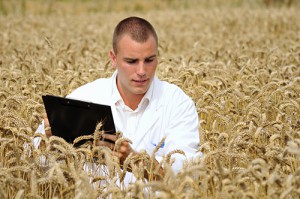 Last year I blogged on unique uses of technology in farming. Spring is in the air here in the Pacific Northwest, so I want to revisit that thread and highlight a technology and company born right here at the University of Oregon. This company is researching the interaction between plants and fertilizers, particularly nitrogen. They have developed a technology and device that will allow a farmer or grower to monitor the nitrogen level of the soil, thus preventing excess fertilization and runoff.
Last year I blogged on unique uses of technology in farming. Spring is in the air here in the Pacific Northwest, so I want to revisit that thread and highlight a technology and company born right here at the University of Oregon. This company is researching the interaction between plants and fertilizers, particularly nitrogen. They have developed a technology and device that will allow a farmer or grower to monitor the nitrogen level of the soil, thus preventing excess fertilization and runoff.
SupraSensor Technologies
SupraSensor Technologies was formed in 2012 from the graduate work of Calden Carroll in partnership with his professors, Darren Johnson and Mike Haley. They discovered that the interaction between plant cells and their nitrogen level could be measured. Nitrogen fertilizer is water soluble and excess nitrogen runs off and mixes with the water table. In some areas of the country, there are large algal blooms that were fed by runoff. Algal blooms change water pH and oxygen levels, which harm fish and other organisms, and some species of algae are toxic, even deadly, to people and animals.
Field Nutrient Sensors™
Carroll and other researchers did not stop at identifying this molecular interaction. They developed a device called a Field Nutrient Sensor™ (FNS™), which measures the nitrogen level in the soil, just below root level. This information is collected wirelessly so that a farmer can determine precisely where to fertilize and when to stop. It is estimated that 30 percent of all fertilizer runs off, so this device would reduce the use of chemicals, thus saving money for the farmer and promoting a sustainable and healthier farm. Collecting the data wirelessly is much less labor intensive and yields more accurate and timely data.
Farming Meets Information Technology
SupraSensor Technologies has test sensors in the field right now and is seeking funding for commercialization. It has secured seed funding from the National Science Foundation and through state and national grants. The ability to collect this important data means that farms will now need information technology experts to not only help with the data collection and wireless networking but also with data analytics to create a coherent picture of the health of the farm, the plants, and the soil. Information technology is emerging from the computer room and finding its way to the farm, the manufacturing floor, the research site, and wherever data is being turned into solutions for a better world.
Thoughts
There are many opportunities developing for IT professionals and it is an exciting time to be involved in tackling real world problems like healthy farms and sustainable ecosystems. Do you know of other technology and research breakthroughs that you would like me to highlight? Let me know if have you cool things that need to be shared.
Kelly Brown is an IT professional and assistant professor of practice for the UO Applied Information Management Master’s Degree Program. He writes about IT and business topics that keep him up at night.




